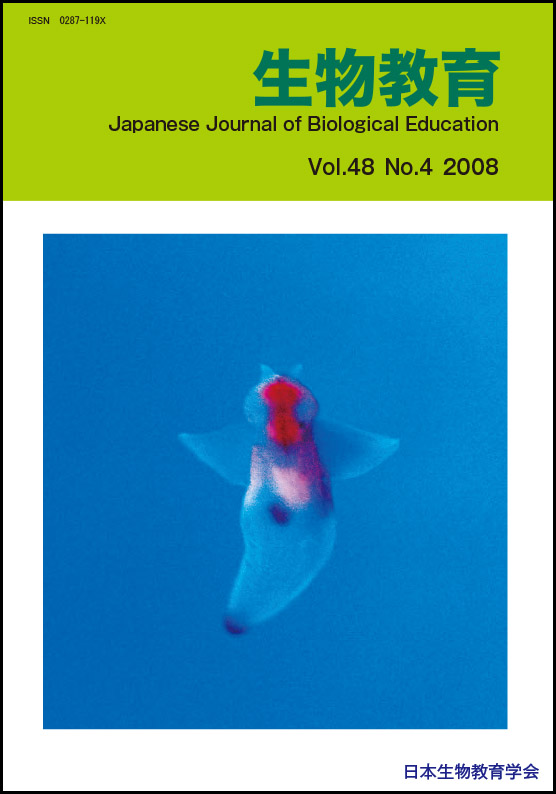
- Issue 4 Pages 197-
- Issue 3 Pages 128-
- Issue 1-2 Pages 2-
- |<
- <
- 1
- >
- >|
-
T. Yamanoi2008Volume 48Issue 4 Pages 197-210
Published: 2008
Released on J-STAGE: September 28, 2019
JOURNAL FREE ACCESSIn this study, Japanese Biology Ⅱ textbooks were compared with ones used in high school of USA and UK and in liberal arts courses at university in order to reveal how much unnecessary and/or inaccurate evolutionary mechanisms are described and how little data about field evidence of evolution are included in them. In addition, the eff ectiveness of studentʼs experiments using origami birds (Avis papyrus) in understanding natural selection was examined by tests carried out before and after the experiment. Japanese Biology Ⅱ textbooks had two extra evolutionary mechanisms (i.e., Lamarckism and orthogenetic theory), and fewer examples of natural selection and genetic drift in the field (two and one examples, respectively). Studentʼs experiments using origami birds were able to be fi nished in one class (45 minutes) and removed studentʼs misunderstanding that natural selection necessarily accompanies combat between organisms.
View full abstractDownload PDF (617K) -
T Ito2008Volume 48Issue 4 Pages 211-220
Published: 2008
Released on J-STAGE: September 28, 2019
JOURNAL FREE ACCESSThe aim of this paper is to investigate the characteristics of biotechnology curriculum contents in secondary school science in UK. For this purpose, “the GCSE biology syllabus,” “the GCSE biology textbooks” and “the GCSE biology examination” were carefully examined as manifest curriculum, and the contents of biotechnology in them were analyzed.The characteristics were pointed out as follows:
1. In GCSE biology, they placed a great deal of weight on biotechnology.
2. The forefront of biotechnology could be studied in detail on the basis of traditional biotechnology.
3. They positively took up economical, environmental, social and ethical issues on the biotechnology for discussion.
4. Biotechnology as a social concern became learning contents both for the Foundation tier and the Higher tier.
5. The textbooks had many examples of daily lives and the contents was understood easily while using many charts and pictures.
View full abstractDownload PDF (375K) -
Y Kon, Y Ohmura2008Volume 48Issue 4 Pages 221-228
Published: 2008
Released on J-STAGE: September 28, 2019
JOURNAL FREE ACCESSLichens are recognized as being sensitive to atmospheric pollutants and have disappeared in many metropolitan and industrial areas. The correlation between sulfur dioxide pollution and declines in lichen communities has been reported in many studies. When lichens are absent within a polluted area, transplantation method may be useful to check the air pollution. Parmotrerma tinctorum (Nyl.) Hale is a common foliose lichen growing in temperate and subtropical zones in Japan. Although P. tinctorum has been known as bioindicator for SO2 pollution (> 0.02 ppm), the transplantation method using this species has not been established yet.
Circular fragments were cut from marginal parts of the thallus of P. tinctorum. They were transplanted on the surface of tree trunks of Cryptomeria japonica in a clean area, and their growth rates were checked every three months by measuring dry weight and area. Both dry weight and area increased about two times that of the initial fragments after six months. Numerous globular protuberances were formed on the fragment margin after six months. These globular protuberances developed into small lobules after nine months. On the other hand, the growth rate of transplanted fragments in urban areas was very low in comparison with that of fragments in suburb areas.The transplant method of P. tinctorum developed in this study may be useful in environmental education in schools to make aware the differences of air quality between urban and suburb areas.
View full abstractDownload PDF (484K)
- |<
- <
- 1
- >
- >|